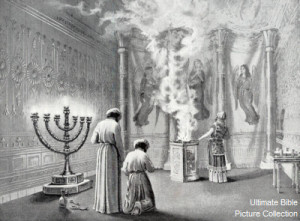The Holy Place
Hebrews 9:1-5
Here at the beginning of the ninth chapter we have a section listing the “CHARACTERISTICS OF THE OLD COVENANT” (MacArthur). Verses 2 – 5 give us a brief description of the old sanctuary, that is, first the tabernacle then the temple. We have here regulations of divine worship, the rites and ceremonies that were instituted by God to help show His Son, the Messiah, the true Savior.
The author rapidly lists the contents of the first tent, beginning with “the candlestick (lampstand),” described at length in Exodus 25:31-39…
The Golden Lampstand
Exo 25:31 “You shall make a lampstand of pure gold. The lampstand shall be made of hammered work: its base, its stem, its cups, its calyxes, and its flowers shall be of one piece with it.
Exo 25:32 And there shall be six branches going out of its sides, three branches of the lampstand out of one side of it and three branches of the lampstand out of the other side of it;
Exo 25:33 three cups made like almond blossoms, each with calyx and flower, on one branch, and three cups made like almond blossoms, each with calyx and flower, on the other branch—so for the six branches going out of the lampstand.
Exo 25:34 And on the lampstand itself there shall be four cups made like almond blossoms, with their calyxes and flowers,
Exo 25:35 and a calyx of one piece with it under each pair of the six branches going out from the lampstand.
Exo 25:36 Their calyxes and their branches shall be of one piece with it, the whole of it a single piece of hammered work of pure gold.
Exo 25:37 You shall make seven lamps for it. And the lamps shall be set up so as to give light on the space in front of it.
Exo 25:38 Its tongs and their trays shall be of pure gold.
Exo 25:39 It shall be made, with all these utensils, out of a talent of pure gold.
Exo 25:40 And see that you make them after the pattern for them, which is being shown you on the mountain. – ESV
25:31–40. The lampstand (menōrâh, hence the Eng. word “menorah” for a Jewish candelabrum) was to be the most ornate piece of furniture in the tabernacle. Its decorative flowerlike cups, buds, and blossoms were formed from one solid piece of gold (vv. 31, 36). On each side of an upright shaft were three branches extended upward (v. 32). Each branch had three … almond flower-shaped cups (v. 33), and the center shaft had four such cups (v. 34). At the top of the center shaft and each of the six branches was a lamp (v. 37). The seven lamps in the lampstand provided light in the tent (v. 37).
The lampstand, which was to burn continually, was serviced by the priests in the morning and at sunset (27:20–21; Lev. 24:3–4). The amount of gold required for this piece of furniture and its accessories—wick trimmers and trays (perhaps for oil)—was a talent, which was about 75 pounds (cf. niv marg.). As the lampstand provided light for the priestly functions before God, so Christ today is the Light of the world (John 8:12), who reveals the way to God (John 14:6, 9).
The author then names “THE TABLE,” described in Exod 25:23-27…
(3) The table of the bread of the Presence.
25:23–30. A table, 1’6” wide, 3’ long, and 2’3” high, was to be made of acacia wood (like the ark, v. 10), covered with … gold and was to be carried by gold-covered poles in the same manner as the ark. A frame about 3” wide (a handbreadth) around the edge of the table would keep objects from falling off. On the table, to be positioned on the north side of the holy place (26:35; 40:22), 12 loaves were to be placed in two piles of 6 each and replaced on each Sabbath (Lev. 24:5–9). Also on the table were to be placed golden plates (perhaps for carrying the loaves), and ladles … pitchers, and bowls for drink offerings. The bread was called the bread of the Presence (kjv, “showbread”) because it was placed in God’s presence (before Me). This table, with its 12 loaves which perhaps represented the 12 tribes of Israel, pictured the fellowship and communion of God with His people. The priests’ eating of the bread (Lev. 24:9) demonstrated that spiritual fellowship supports spiritual life.
and “the laying out of loaves,” of which Exod 25:30 as well as Lev 24:5-9 speak…
30 “You shall set the bread of the Presence on the table before Me at all times.
5 ‘Then the anointed priest is to take some of the blood of the bull and bring it to the tent of meeting,
6 and the priest shall dip his finger in the blood and sprinkle some of the blood seven times before the Lord, in front of the veil of the sanctuary.
7 ‘The priest shall also put some of the blood on the horns of the altar of fragrant incense which is before the Lord in the tent of meeting; and all the blood of the bull he shall pour out at the base of the altar of burnt offering which is at the doorway of the tent of meeting.
8 ‘He shall remove from it all the fat of the bull of the sin offering: the fat that covers the entrails, and all the fat which is on the entrails,
9 and the two kidneys with the fat that is on them, which is on the loins, and the lobe of the liver, which he shall remove with the kidneys.
25:23–30. A table, 1’6” wide, 3’ long, and 2’3” high, was to be made of acacia wood (like the ark, v. 10), covered with … gold and was to be carried by gold-covered poles in the same manner as the ark. A frame about 3” wide (a handbreadth) around the edge of the table would keep objects from falling off. On the table, to be positioned on the north side of the holy place (26:35; 40:22), 12 loaves were to be placed in two piles of 6 each and replaced on each Sabbath (Lev. 24:5–9). Also on the table were to be placed golden plates (perhaps for carrying the loaves), and ladles … pitchers, and bowls for drink offerings. The bread was called the bread of the Presence (kjv, “showbread”) because it was placed in God’s presence (before Me). This table, with its 12 loaves which perhaps represented the 12 tribes of Israel, pictured the fellowship and communion of God with His people. The priests’ eating of the bread (Lev. 24:9) demonstrated that spiritual fellowship supports spiritual life.
(4) The golden lampstand. – Zuck
9:1 “the first” The regulations for sacrifice and worship connected with the tabernacle are found in Exodus, Leviticus, and Numbers.
© “covenant” This is not in the Greek text. Most English translations assume it. However, H. E. Dana, in his Jewish Christianity, p. 255, believes that it should be translated “first ministry” because chapter 9 is presenting another evidence of Christ’s superior ministry (cf. 8:6). Notes the comparison of the two covenants:
|
The First Ministry |
The Second Ministry |
|
| An earthly service—“of this world.” | A heavenly service—“not of this creation.” | |
| Human equipment—“there was a tabernacle constructed.” | Divine equipment—“not made with hands.” | |
| External effects—“cannot as touching the conscience make the worshiped perfect.” | Internal effects—“cleanse your conscience from dead works to serve the living God.” | |
| Temporary in nature—“carnal regulations set up pending a time of construction.” | Permanent in nature—“the promise of the eternal inheritance.” |
9:2 “a tabernacle” This refers to the tabernacle in the wilderness, which is described in detail in Exod. 25–27 and built in 36–38, 40. The author of Hebrews refers to the inner tent as the first (outer) tabernacle (the holy place) and the second (inner) tabernacle (the Holy of Holies).
© “the lampstand” This refers to one lamp with seven containers burning olive oil, located in the holy place. It is referred to in Exod. 25:31–40 and Lev. 24:1–4. It was called the Menorah, which is the Hebrew term for “lampstand.” Solomon expanded the lamp to 10 arms (cf. 1 Kings 7:49; 2 Chr. 4:7).
© “table and the sacred bread” This was a table located in the holy place holding twelve large (15 lb.) loaves of bread. They were replaced weekly and became food for the Priests (cf. Exod. 25:23–30; 37:10–16; Lev. 24:5–9). They represented God’s promised physical provision for the twelve tribes of Jacob.
© “the holy place” This is the outer room of the tent in which the priests ministered daily. It measured 20 cubits by 10 cubits (cf. Exod. 25–27). The author of Hebrews usually uses this term (hagia) with the article (cf. 9:8, 25; 13:11) and uses it for the inner or second part of the sacred tent called the Holy of Holies (cf. v. 25) where the Ark was placed, but in this verse the article is absent and the term refers to the outer two-thirds of the sacred tent, called the holy place. – Utley
ONLY TWO CHAPTERS IN THE BIBLE ARE DEVOTED TO THE STORY OF THE CREATION (GENESIS 1-2), BUT IN STARK CONTRAST MORE THAN FIFTY CHAPTERS ARE CENTERED ON THE TABERNACLE (NOTE PARTICULARLY EXODUS 25-40).
“THE TABERNACLE IS IMPORTANT AND DEMANDS ATTENTION IN OUR STUDY, BECAUSE IT IS A GIANT PORTRAIT OF JESUS CHRIST. EVERYWHERE YOU LOOK IN THE TABERNACLE YOU CAN SEE HIM.” – MacArthur
BRINGS TO MIND PASTOR MATT’S EXCELLENT RECENT STUDY OF THE TABERNACLE AND IT’S INTIMATE CONNECTION TO JESUS IN EXODUS, DOES IT NOT?
Professor Thomas A. Rohm



